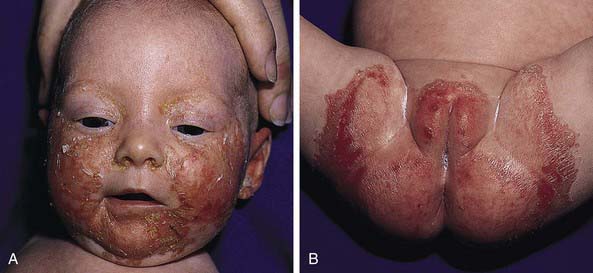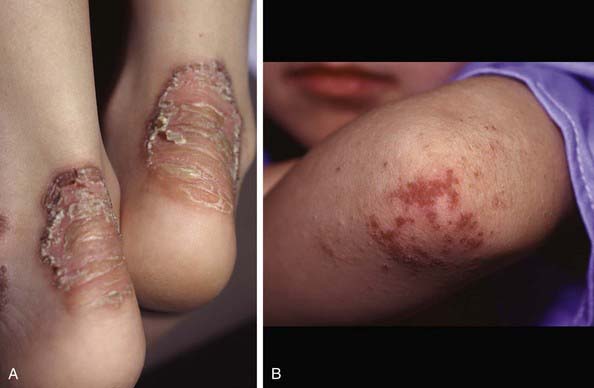Chapter 663 Nutritional Dermatoses
Acrodermatitis Enteropathica
Acrodermatitis enteropathica is a rare autosomal recessive disorder caused by an inability to absorb sufficient zinc from the diet. The genetic defect is in the intestinal zinc specific transporter gene SLC39A4. Initial signs and symptoms usually occur in the first few months of life, often after weaning from breast milk to cow’s milk. The cutaneous eruption consists of vesiculobullous, eczematous, dry, scaly, or psoriasiform skin lesions symmetrically distributed in the perioral, acral, and perineal areas (Fig. 663-1) and on the cheeks, knees, and elbows (Fig. 663-2). The hair often has a peculiar, reddish tint, and alopecia of some degree is characteristic. Ocular manifestations include photophobia, conjunctivitis, blepharitis, and corneal dystrophy detectable by slit-lamp examination. Associated manifestations include chronic diarrhea, stomatitis, glossitis, paronychia, nail dystrophy, growth retardation, irritability, delayed wound healing, intercurrent bacterial infections, and superinfection with Candida albicans. Lymphocyte function and free radical scavenging are impaired. Without treatment, the course is chronic and intermittent but often relentlessly progressive. When the disease is less severe, only growth retardation and delayed development may be apparent.

Figure 663-1 A, Periorificial eruption. B, Diaper rash. The skin findings are typical of zinc deficiency, in this case caused by low levels of zinc in breast milk.
(From Eichenfield LF, Frieden IJ, Esterly NB: Textbook of neonatal dermatology, Philadelphia, 2001, WB Saunders, p 254.)

Figure 663-2 A, Psoriasiform lesion of zinc deficiency dermatitis on the ankles. B, Similar lesions on the elbows.
The diagnosis is established by the constellation of clinical findings and detection of a low plasma zinc concentration. Histopathologic changes in the skin are nonspecific and include parakeratosis and pallor of the upper epidermis. The variety of manifestations of the syndrome may be due to the facts that zinc has a role in numerous metabolic pathways, including those of copper, protein, essential fatty acids, and prostaglandins, and that zinc is incorporated into many zinc metalloenzymes.
Oral therapy with zinc compounds is the treatment of choice. Optimal doses range from 50 mg/24 hr of zinc sulfate, acetate, or gluconate daily for infants up to 150 mg/24 hr for children. Plasma zinc levels should be monitored, however, to individualize the dosage. Zinc therapy rapidly abolishes the manifestations of the disease. A syndrome resembling acrodermatitis enteropathica has been observed in patients with secondary zinc deficiency due to long-term total parenteral nutrition without supplemental zinc or to chronic malabsorption syndromes. A rash similar to that of acrodermatitis enteropathica has also been reported in infants fed breast milk that is low in zinc and in those with maple syrup urine disease, organic aciduria, methylmalonic acidemia, biotinidase deficiency, essential fatty acid deficiency, severe protein malnutrition (kwashiorkor), and cystic fibrosis.
Essential Fatty Acid Deficiency
Essential fatty acid deficiency causes a generalized, scaly dermatitis composed of thickened, erythematous, desquamating plaques. The eruption has been induced experimentally in animals fed a fat-free diet and has been observed in patients with chronic severe malabsorption, such as in short-gut syndrome, and in those sustained on a fat-free diet or fat-free parenteral alimentation. Linoleic acid (18:2 n-6) and arachidonic acid (20:4 n-6) are deficient, and an abnormal metabolite, 5,8,11-eicosatrienoic acid (20:3 n-9), is present in the plasma. Alterations in the triene:tetraene ratio are diagnostic. Additional manifestations of essential fatty acid deficiency include alopecia, thrombocytopenia, and failure to thrive. The horny layer of the skin contains microscopic cracks, the barrier function of the skin is disturbed, and transepidermal water loss is increased. Topical application of linoleic acid, which is present in sunflower seed and safflower oils, may ameliorate the clinical and biochemical skin manifestations. Appropriate nutrition should be provided.
Kwashiorkor
Severe protein and essential amino acid deprivation in association with adequate caloric intake can lead to kwashiorkor, particularly at the time of weaning to a diet that consists primarily of corn, rice, or beans (Chapter 43). Diffuse fine reddish brown scaling (enamel/flaky paint sign) is the classic cutaneous finding. In severe cases, erosions and linear fissures develop (Fig. 663-3). Sun-exposed skin is relatively spared, as are the feet and dorsal aspects of the hands. Nails are thin and soft, and hair is sparse, thin, and depigmented, sometimes displaying a “flag sign” consisting of alternating light and dark bands that reflect alternating periods of adequate and inadequate nutrition. The cutaneous manifestations may closely resemble those of acrodermatitis enteropathica. The serum zinc level is often deficient, and in some cases, skin lesions of kwashiorkor heal more rapidly when zinc is applied topically.
Cystic Fibrosis (Chapter 395)
Protein-calorie malnutrition develops in 5-10% of patients with cystic fibrosis. Rash in infants with cystic fibrosis and malnutrition is rare but may appear by age 6 mo. The initial eruption consists of scaling, erythematous papules and progresses in 1-3 mo to extensive desquamating plaques. The rash is accentuated around the mouth and perineum and on the extremities (lower > upper). Alopecia may be present, but mucous membranes and nails are uninvolved.
Pellagra (Chapter 46)
Pellagra manifests as edema, erythema, and burning of sun-exposed skin on the face, neck, and dorsal aspects of the hands, forearms, and feet. Lesions of pellagra may also be provoked by burns, pressure, friction, and inflammation. The eruption on the face frequently follows a butterfly distribution, and the dermatitis encircling the neck has been termed “Casal’s necklace.” Blisters and scales develop, and the skin increasingly becomes dry, rough, thickened, cracked, and hyperpigmented. Skin infections may be unusually severe. Pellagra develops in patients with insufficient dietary intake or malabsorption of niacin and/or tryptophan. Administration of isoniazid, 6-mercaptopurine, or 5-fluorouracil may also produce pellagra. Nicotinamide supplementation and sun avoidance are the mainstays of therapy.
Scurvy (Vitamin C or Ascorbic Acid Deficiency) (Chapter 47)
Scurvy manifests initially as follicular hyperkeratosis and coiling of hair on the upper arms, back, buttocks, and lower extremities. Other features are perifollicular erythema and hemorrhage, particularly on the legs and advancing to involve large areas of hemorrhage; swollen, erythematous gums; stomatitis; and subperiosteal hematomas. The most common risk factors are alcoholism, low socioeconomic status, and psychiatric disease that results in poor nutrition. The best method of confirmation of a clinical diagnosis of scurvy is a trial of vitamin C supplementation.
Vitamin A Deficiency (Chapter 45.1)
Vitamin A deficiency manifests initially as impairment of visual adaptation to the dark. Cutaneous changes include xerosis and hyperkeratosis and hyperplasia of the epidermis, particularly the lining of hair follicles and sebaceous glands. In severe cases, desquamation may be prominent.
Azevedo PM, Gavassone-Dias MF, Avelleira JC, et al. Acrodermatitis enteropathica in a full term breast-fed infant: case report and literature review. Int J Dermatol. 2008;47:1056-1057.
Heath ML, Sidbury R. Cutaneous manifestations of nutritional deficiency? Curr Opin Pediatr. 2006;18:417-422.
Leger D. Scurvy: reemergence of nutritional deficiencies. Can Fam Physician. 2008;54:1403-1406.
Marcason W. Can cutaneous application of vegetable oil prevent an essential fatty acid deficiency. J Am Diet Assoc. 2007;107:1262.
